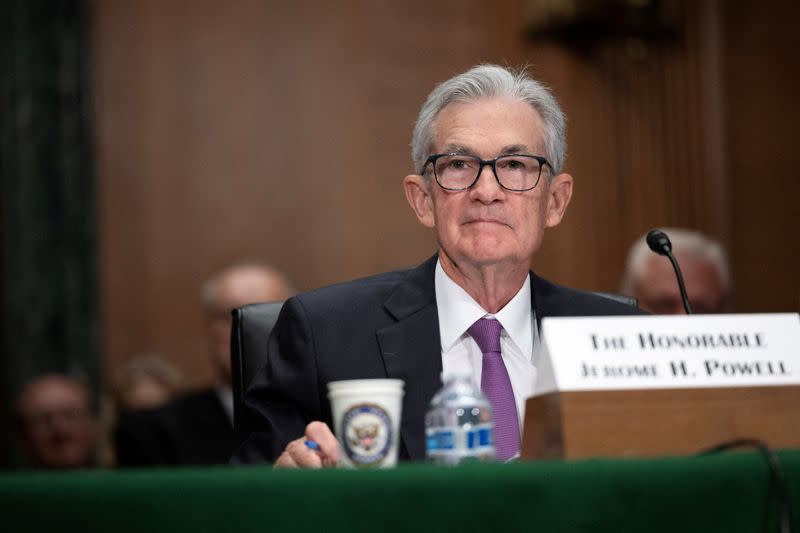Emergency Fed bank effort ends lending, as eyes turn to discount window

By Michael S. Derby
(Reuters) - A Federal Reserve facility launched in haste a year ago amid the heavy stress triggered by Silicon Valley Bank's collapse closes for new business on Monday, amid evidence it helped turn the tide of trouble that risked derailing the economy and upending the central bank’s efforts to lower inflation.
A year after the Bank Term Funding Program was unveiled on a Sunday afternoon -- when regulators feared a systemwide bank run might unfold the next day -- deposits have stabilized, bank loan books overall are growing, no bank of meaningful size has failed in 10 months, and the Fed was not forced to change its monetary policy footing.
The program “certainly worked” given the rebound of the banking sector, said Steven Kelly, associate director of research at the Yale School of Management's Program on Financial Stability.
But the sunset of new lending at the BTFP is raising questions about how the central bank will respond to the inevitable return one day of banking trouble. Kelly and others think the Fed would not want to go down this route again if it could avoid it. That’s bringing fresh attention to the Fed's discount window, its long-running and often shunned bank lending facility, seen as the lender of last resort.
The BTFP tackled a liquidity crunch after the world's first social media-induced bank run put SVB out of business in a matter of days, with a clutch of other banks failing in its wake. To ensure deposit-taking banks could get the money they needed, the BTFP offered loans on eligible collateral without the penalties usually imposed by Fed emergency lending, doing so on relatively cheap terms.
That configuration generated large amounts of borrowing even when the most acute phase of the crisis was in the rear view mirror. Jumps in borrowing at the discount window last spring quickly abated to normal levels while BTFP borrowing ground ever higher as banks appeared to be exploiting its low rate relative to other sources of short-term funding.
In late January the Fed shut down that arbitrage play, and new loans have all but dried up since, with the facility's credit outstanding holding at around the $160 billion mark.
'THE STIGMA PROBLEM'
For all its apparent success, the fact that the BTFP existed at all is an “admission of failure” on the Fed’s part, said Peter Conti-Brown, a professor at the Wharton School of the University of Pennsylvania. The Fed’s “failure of Discount Window management might have made the Bank Term Funding Program necessary,” Conti-Brown said.
At some level, Fed officials may agree, and are acting to address the situation.
Fed Chair Jerome Powell told senators Thursday "we need to do more to eliminate the stigma problem, and we need to make sure that banks are actually able to use [the Discount Window] when they need to use it.”
Eliminating discount window stigma has been a desire of the Fed for many years. Even as Fed officials encourage its use, large firms remain hesitant, fearing it will signal they are in trouble. They also worry the borrowing would invite regulators to have a closer look at them.
Some experts reckon stigma fears can be reduced by the Fed tolerating notable levels of borrowing in otherwise placid times. Some also believe that as the Fed moves toward pushing bank preparedness to use the discount window, stigma could be further reduced by allowing this type of liquidity to factor into bank stress-testing scenarios.
"The Fed recognizes that it needs to fix the profound stigma associated with using the window that's largely the fault of the Fed itself," said Bill Nelson, a former top Fed staffer who now serves as chief economist at the Bank Policy Institute, a lobbying group.
The Fed seems committed to fixing the situation and it appears the Fed is conveying discount window usage is "just a business decision on the part of the banks" and "a willingness to use it is a good thing for the financial system, not a bad thing," Nelson said.
Amid that reform process, banks may lean into funding from the Federal Home Loan Banks, Bank of America analysts said in a research note Friday. Loans from the BTFP could be taken in terms of up to a year and it's unclear how quickly some of that borrowing will roll off and if affected banks will need to replace it, possibly via the FHLB banks, the researchers said.
‘ROOM TO MANEUVER’
One other benefit of the BTFP relates to the Fed’s work to lower inflation. The Fed started raising rates in March 2022 and it was even able to push through an increase last March, just 10 days after launching the BTFP, with no guarantee then it would help avert a wider crisis.
In the view of New York Fed President John Williams, that’s because the Fed's efforts last spring allowed them a luxury not often available in the past: To conduct financial stability and monetary policy work separately, rather than forcing a trade off between the two.
The Fed was “able to do exactly what you want to do in the textbook: You apply liquidity policies, you apply resolution solutions...We did that with discount window kind of programs” and other regulatory actions, which left “monetary policy the room to maneuver,” Williams said Friday in an appearance in London.
(Reporting by Michael S. Derby; Editing by Dan Burns and Chizu Nomiyama)
